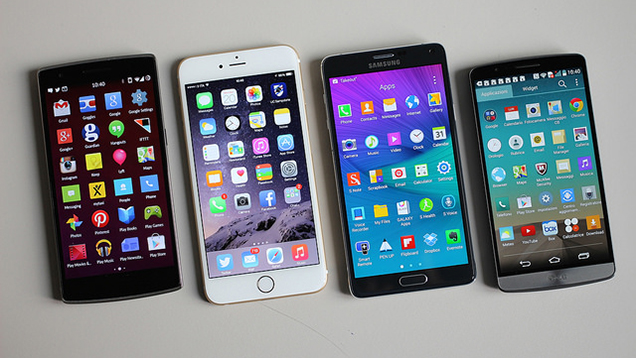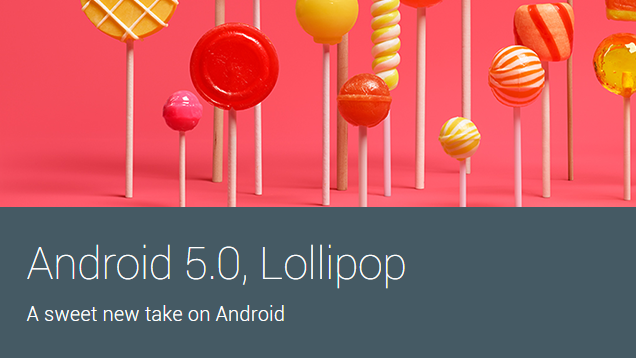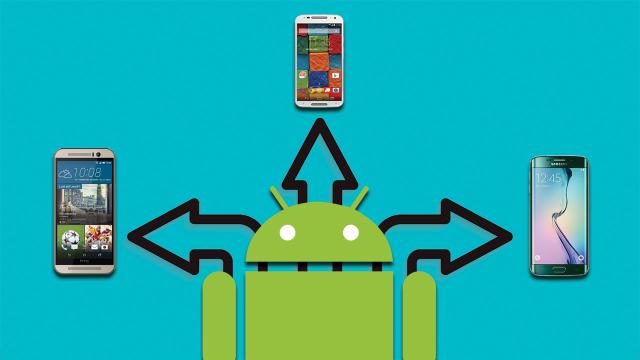Fun fact: there are roughly seven different model Android phones per human on the planet. While that statement isn’t actually true, it seems close. Since you’ve got things to do, here’s what matters when buying a new Android phone.
Photo by Maurizio Pesce
We’ve said it before and we’ll say it again: there is no single “best” Android phone. At this point, you can think of buying a phone like buying a laptop: Get the one that’s best for your needs and does what you want.
Spend time thinking about your needs. If the software doesn’t do what you want, it’s possible to change most of it, but you can’t alter terrible battery life, or how it feels to hold it every day. Everyone’s needs are different, so don’t be worried about there being a “better” phone out there. Get the one that you will be happy with until your next upgrade.
When (And How Often) Should I Upgrade?

Not everyone upgrades their phones on the same schedule — and for good reason. These suckers are expensive. However, carrier subsidies and payment plans have made it possible for most people to maintain an upgrade cycle of every two years or so. That also means that phones aren’t necessarily built to last as long as computers or even tablets.
There are a few ways to get your hands on a new phone. Your approach will depend on how often you want (or can afford) to upgrade:
- Two-year contracts with your carrier: The default model which most people are familiar with is to purchase a phone on a 24-month contract. You’ll typically pay the monthly free for the plan — anywhere from $30 to $130 depending on how much data and calling allowance you want — plus a monthly contribution towards the handset. This spreads out the cost of the device and in some cases can score you a discount. On the most expensive plans from Telstra, Optus and Vodafone, you typically won’t pay any more than the cost of the plan itself, unless you want a particularly high-end phone model. The downside is that you’re stuck with the same carrier for two years, which can be a problem if network performance degrades or you move house. Telstra offers an option where you can pay an additional fee and upgrade your phone every 12 months.
- Buying phones outright: High end phones typically cost $600 and up, depending on the model. However, in the Android market there are also cheaper versions available, and many will run relatively recent versions of Android. Buying outright means you aren’t tied to a carrier, and if you choose the right prepaid option, you can actually get more data for less money.
- Buying used phones: One of the upsides to having such a huge collection of phones to choose from is that used models sell fairly cheaply. You can often find used flagship Android phones for half the price of a new one. We have a guide on how to buy used smartphones without getting screwed here.
If you want a new phone, you have plenty of options. What you need to determine is whether your current phone will keep working, and if the phone you replace it with will be a solid improvement.
Of course, no one wants to buy a new phone only to find out that the company released the new version a month later. While manufacturers and carriers have frustratingly unpredictable release schedules, there are certain times of the year that bring plenty of news:
- Autumn (Samsung, HTC, Google): Over the last couple of years, HTC, Samsung and Google have all announced major products between February and May, with models typically launching at Mobile World Congress and then hitting Australia a few months later. We’ve rounded up the main announced phones from 2015 here. Google sometimes announces new phones at its I/O developer conference, which is happening in late May this year.
- Spring (Motorola, LG, Google again): Motorola and LG have planted their flags in the second half of the year for new releases. Google has also released new Nexus devices around October or November. In 2014, that included a new Nexus phone, but it’s still unclear if that will be a consistent pattern.
Of course, if you’re waiting on all companies to hear everyone’s announcements, that rules out pretty much everything from January to December. The better solution is to find a manufacturer you like, wait to see what their new stuff is this year, and then buy shortly after that.
What Features Really Matter In A New Phone?

Unless you’re using your phone for hardcore gaming, chances are most of the spec wars don’t concern you. Mobile processors are fast enough to do just about everything you’ll ever need, and 2-3GB of RAM is becoming standard. Even displays are so over-engineered that we’ve started arguing about whether or not the human eye can even see that many pixels. It’s safe to say some things matter more in a phone than others.
Here are some of the features that can actually differ wildly from one phone to another:
Battery
This one is getting bumped up higher than it’s been in the past because it’s one of the biggest problems that still hasn’t been solved. While some phones will improve battery life by tossing in a massive battery (to match the massive screen), others aim to make more efficient use of what they have. Unfortunately, even reviews of battery life can be off the mark, since they only have limited amounts of time to use a device. However, benchmarks can help you get an idea of which phone is beating the competition. It’s also worth mentioning that quick chargers are helping alleviate battery issues. Put simply, these are chargers that can fill up your phone’s battery in a much shorter amount of time. If you’re interested in this, be sure to check to see if your phone supports it and which chargers you need before you buy.
Camera
When manufacturers advertise their phone, they’re likely to tell you how many megapixels it has. Which sucks because that’s barely relevant. Camera performance is affected by how the device handles low-light, how it’s calibrated, extra software processing that’s done to the image, and a wide variety of other factors. The best way to tell whether a phone’s camera is good is an old-fashioned comparison review. Of course, don’t forget that how you take your pictures will have an effect, too. If you’re going to do it, may as well do it right.
Display
When we last left our heroes, we were discussing whether or not a 1080p display really mattered in a smartphone. While you probably don’t unless your phone is larger than 5″, many major flagships have just gone ahead and made their phones bigger than 5″ anyway. Regardless, much like with cameras, there are many other factors that go into how a display looks. AMOLED versus LCD, viewing angles, performance in sunlight, colour calibration. Making a good-looking display is just as complex and as subjective as a good camera is. Rather than worry about specs, go to your local store and take a look at the phones in person. It’s the only way to know if you’ll really like what you see.
Manufacturer Skins
Every manufacturer wants to put their own spin on Android, and for good reason. They’re not competing much on battery life, after all. However, manufacturer skins can drastically change your Android experience, so it’s important to know what you’re getting with a different interface.
Each manufacturer has a few features that stand out. While we could not possibly do a comprehensive comparison of each, here are a few that are notable on each device:
- HTC Sense: Blinkfeed and Unbundled Apps. HTC’s custom launcher aims to do on your home screen what you’re probably already doing with your phone: mindlessly scroll through feeds. Not everyone loves it, but some do. Also, HTC has followed Google’s lead by unbundling many applications so that they can be updated apart from the OS, which means if you like HTC’s camera app or launcher, you won’t need to wait months (or buy a new phone) to get new features.
- Samsung Nature UX: Samsung Pay and Curved Edge displays. Samsung experiments wildly with its phones, and many cool (or less cool) features are tied to hardware. Samsung has announced a mobile payments processor that promises to use regular old magnetic card readers — as opposed to NFC payments — which means you might actually be able to use your S6 to pay at most places you already go. And the Edge version has a curved display that wraps around the side.
- Motorola: Voice Activation and Smart Controls. Motorola’s skin is perhaps the least invasive, but the company still makes some changes. For example, it allows you to control the phone with your voice without touching it. You can customise voice triggers in the new version, and it can intelligently change how it treats notifications when you’re driving, sleeping, or in a meeting. Of all the manufacturers, it’s the most subtle, but perhaps some of the most helpful as well.
These are just some examples, and every manufacturer has dozens of features it stuffs into Android. The key takeaway, though, is that if you have some special feature you really like on your phone right now, try to check and see if it’s coming from Google or your manufacturer before you change to a different company. You may find that Android is an entirely different beast when you switch.
Android OS Updates

We’ve talked before about how Android OS updates aren’t necessarily as important as long as Play Services remains updated. By removing much of the compatibility framework and updating it separately, Google has made it possible to get much of the latest Android experience, even if you have an older version. However, Google has also recently launched Android Lollipop and that’s a pretty major revision.
Unfortunately, the situation hasn’t changed much over the years. If you want a device that gets fast updates and won’t get left behind, the Nexus phones are for you. If you want to get at least some hope of getting updates without going Nexus, stick to the most popular flagships. Historically, these are the ones most likely to get updated at some point, solely due to market pressure.
What If I Care About Rooting?

Rooting Android phones isn’t as necessary as it used to be, but there are still arguments to be made in favour of doing so. Not all phones make it easy, though. If you want to crack open your device and give it the custom treatment, here are some guidelines for what to consider:
- Nexus devices: Google’s reference devices also double as its developer platform. For that reason, it’s stupid easy to unlock your device. While most unofficial root methods use an exploit of some kind to gain access, Google gives it to you properly. This is the one guaranteed way to avoid hassles and get developer support for your device from the root community.
- Popular phones: The more people trying to work on a device, the more likely it is that you’ll be able to gain root access if there’s not an easy way already. Of course, nothing is a guarantee, and you’ll still have to deal with carrier shenanigans, but if you’re one of three people who want to buy the Samsung Obscure A42, don’t count on someone else making a tool to give you one-click root access.
There are also certain things you should actively avoid if you want to root your phone:
- Obscure devices with low specs: It might be possible to get root access on your Kyocera Whatever the New One’s Called, but you shouldn’t count on a lot of popular ROM support in a timely manner.
- Devices with locked bootloaders: Locking a bootloader won’t guarantee that you can’t get root. However, with so many options available for phones that make root easily available, or at least don’t lock bootloaders, developer attention isn’t going to be as strongly focused on these devices as it has been in the past.
If you’ve read all this and you’re still stressed out, don’t be. Most Android phones on the market right now are actually pretty awesome. Samsung, HTC, Motorola, Sony and LG have all managed to crank out devices that will make any moderately savvy smartphone user happy. And even if they don’t, you can download most of the apps you need to replace the skinned experience anyway. Leave the arguing about which phone can beat up whose dad for the flame wars.

Comments
2 responses to “How To Pick Your Next Android Phone: 2015 Edition”
Don’t forget Huawei. They have some killer devices atm and they are getting stronger every day from what I can see
new samsung galaxy, and htc one hit the market every april. New iphone and samsung note hit the market in september. Basically without fail.